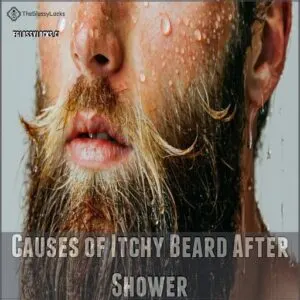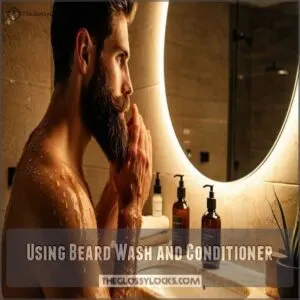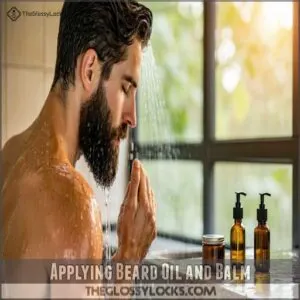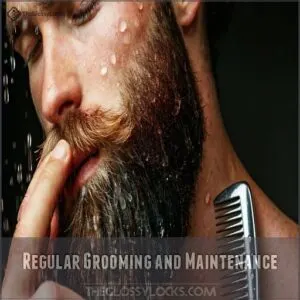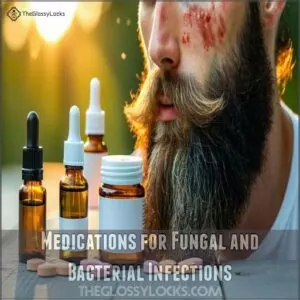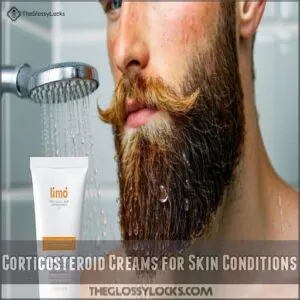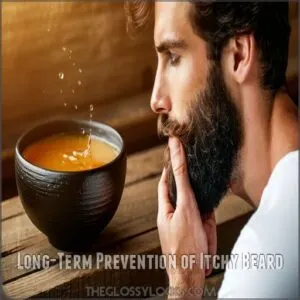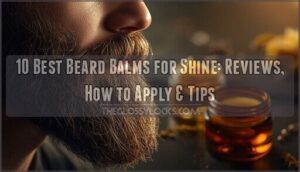This site is supported by our readers. We may earn a commission, at no cost to you, if you purchase through links.
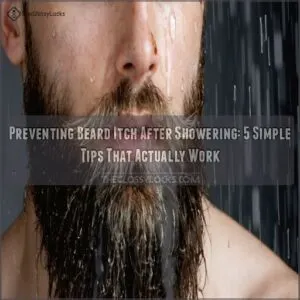
Think of your facial hair like a prized garden – it needs the right care to thrive. Regular maintenance with proper beard wash, oil, and balm creates a protective barrier against irritation.
A balanced diet rich in vitamins and proper hydration strengthens your beard from within. The secret to beard mastery lies in understanding how these elements work together.
Table Of Contents
- Key Takeaways
- Causes of Itchy Beard After Shower
- Preventing Itchy Beard With Proper Care
- Importance of Hydration and Diet
- Medical Treatments for Itchy Beard
- Long-Term Prevention of Itchy Beard
- Frequently Asked Questions (FAQs)
- Why does my beard itch after shower?
- How do I stop my beard from itching?
- How do I treat my beard after a shower?
- How to make a beard less scratchy?
- Can hard water affect my beard after showering?
- How long should I wait before styling post-shower?
- Should I use hot or cold water rinse?
- When is the best time to shower with beard?
- Conclusion
Key Takeaways
- You’ll prevent beard itch by using lukewarm water instead of hot during showers, as hot water strips away natural oils that protect your skin and facial hair from irritation.
- You should pat your beard damp (not completely dry) after showering, then immediately apply beard-specific products like oil or conditioner to lock in moisture and create a protective barrier.
- You can maintain healthier facial hair by establishing a regular grooming routine that includes proper trimming, gentle brushing with a boar bristle brush, and using specialized beard wash instead of regular shampoo.
- You’ll reduce irritation by staying hydrated, eating a balanced diet rich in proteins and healthy fats, and getting adequate sleep – these factors directly impact your skin’s health and your beard’s condition.
Causes of Itchy Beard After Shower
After a shower, your beard may feel itchy due to factors like dry skin, irritation, or trapped moisture under the hair.
Understanding these causes helps you manage discomfort and maintain healthier skin and facial hair.
Dry Skin and Its Effects
Dry skin after a shower often disrupts your skin barrier function, stripping natural oils essential for hydration. Cold weather or hot water worsens this, leading to dry scalp issues and an itchy beard.
Conditions such as seborrheic dermatitis can exacerbate beard itch.
Incorporate winter skin care by using a gentle beard moisturizer immediately after showering. This traps in moisture, supports humidity control, and guarantees itch-free beard maintenance for effective beard itch prevention.
Folliculitis and Its Symptoms
Folliculitis can sneak up on you after a shower, leaving red, pimple-like bumps and an irritating, itchy beard.
It’s often caused by:
- Blocked hair follicles from sweat or oils
- Bacterial infection signs like swelling or pus
- Fungal infections irritating follicles
- Ingrown hair solutions gone wrong
- Skin irritation triggers like harsh cleaners
Proper care prevents this skin problem.
Pseudofolliculitis Barbae and Its Causes
Shaving too close often triggers pseudofolliculitis barbae, a common cause of razor bumps, especially in individuals with curly hair.
Ingrown hairs curve back into the skin, causing inflammation and itchiness.
Adjusting shaving techniques, like shaving every other day or letting the beard grow, can reduce irritation.
To prevent itchy beard issues, considering beard care tips is essential for maintaining healthy skin.
Proper beard skin care helps prevent itchy beard issues and keeps your skin healthy.
Seborrheic Dermatitis and Its Impact
Seborrheic dermatitis can leave your beard itchy and irritated, with skin flakes and greasy scaling being common symptoms.
This condition often worsens after showering due to changes in moisture levels and skin sensitivity.
Incorporating regular beard skin care with a gentle scalp treatment or antifungal product can help in soothing beard itch while preventing irritation and skin flakes from returning.
Tinea Barbae and Its Treatment
Tinea barbae, a skin fungus infecting facial hair, often causes redness, irritation, and itching. Tackling this requires proper beard hygiene and effective treatments, including learning how to stop itching.
Here’s how you can achieve beard itch relief:
- Wash regularly using antifungal beard wash.
- Apply antifungal creams for targeted tinea treatment.
- Avoid sharing razors.
- Trim and clean your beard routinely.
- Seek medical advice for severe infections.
Preventing Itchy Beard With Proper Care
Taking proper care of your beard after showering can keep itchiness at bay and maintain healthy skin underneath.
Simple steps like using the right products and regular grooming make all the difference.
Trimming and Brushing Techniques
Investing in a beard trimmer tool is essential for maintaining a neat and tidy beard. Regular beard trimming helps avoid stray hairs and reduces ingrown risks, keeping beard itch at bay.
Effective beard shaping after showering promotes healthy growth and smoother grooming sessions.
Use a beard brush or comb to untangle knots and improve hair texture. A boar bristle brush distributes oils evenly, while different brush styles cater to various facial hair types.
Using Beard Wash and Conditioner
Now that you’ve got your trimming technique down, let’s tackle proper beard hygiene. Your regular hair shampoo won’t cut it for preventing itchiness – you’ll need specialized beard wash instead.
Use beard products 1-2 times weekly to avoid stripping natural oils, and on other days, a quick water rinse does the trick. Choosing the right beard wash products is essential for maintaining a healthy beard.
Quality facial cleansers and hair softeners will keep your beard clean and skin moisturized.
Applying Beard Oil and Balm
After cleansing your beard, it’s time to lock in that moisture. Beard oil and balm work together as your power duo for skin hydration and beard softening.
Here’s how to make the most of these beard moisturizing essentials: Understanding beard care routine is essential for preventing itchiness.
- Apply beard oil right after showering while your pores are still open
- Massage the oil into your skin, not just the hair, for maximum benefits
- Start with 3-4 drops for shorter beards, 6-8 for longer ones
- Layer beard balm over oil to seal in moisture
- Target problem areas where you feel the most itchiness
Regular Grooming and Maintenance
Setting aside ten minutes each morning for beard grooming pays off big time.
Start with a gentle facial massage to stimulate blood flow, then use circular motions to exfoliate the skin beneath.
Regular beard trimming keeps split ends at bay, while proper hair conditioning prevents that dreaded post-shower itch.
Importance of Hydration and Diet
You’ll be surprised how much your diet and water intake affect your beard’s health, as proper hydration and nutrients directly impact the condition of your facial hair and the skin beneath it.
What you eat and drink plays such a significant role that you can often prevent post-shower beard itch by simply drinking enough water and maintaining a balanced diet rich in vitamins and minerals.
Drinking Water for Healthy Skin
Beyond your regular beard care routine, skin hydration plays a game-changing role in maintaining an itch-free beard. Your water intake directly affects your skin’s moisture levels, which can make or break your beard health.
Think of your skin as a plant – it needs consistent watering to thrive. Understanding dehydrated skin care is essential to addressing the root causes of itchiness and dryness.
- Start your day with two glasses of water before your morning coffee
- Space out your fluid balance throughout the day instead of chugging all at once
- Keep a reusable water bottle within arm’s reach during work hours
- Choose water-rich beverages like coconut water or herbal tea when you need variety
Eating a Balanced Diet for Beard Growth
Fueling your beard growth starts with what’s on your plate.
Load up on lean protein sources like chicken and salmon to build strong hair, while nuts and chickpeas boost testosterone with zinc.
Don’t forget healthy fats from avocados and seeds – they’re your beard’s natural moisturizer.
Whole grains and iron-rich foods like spinach and lentils complete your beard nutrition plan for maximum growth and thickness.
Foods Rich in Beta-carotene and Vitamin D
Want to boost your beard health naturally? Load up your plate with Beta Carotene powerhouses like sweet potatoes, carrots, and spinach.
For Vitamin D sources, try fatty fish, egg yolks, and fortified cereals. These nutrients are essential for reducing beard itch and promoting an itch-free beard.
Consider beard supplements if you can’t get enough through food alone, but always check with your doctor first.
Avoiding Stress and Getting Enough Sleep
Stress and poor sleep wreak havoc on your beard health, often leading to that frustrating beard itch.
Your body needs proper rest to maintain healthy hair follicles and reduce inflammation.
Here are four key stress management techniques that promote an itch-free beard:
- Practice deep breathing or meditation before bed
- Maintain consistent sleep patterns, aiming for 7-8 hours
- Exercise regularly to reduce cortisol levels
- Create a relaxing bedtime routine away from screens
Medical Treatments for Itchy Beard
If you’re struggling with persistent beard itch after trying basic remedies, you’ll be glad to know that effective medical treatments are available.
Your doctor can prescribe medications like antifungal creams or corticosteroids that target specific skin conditions causing your beard discomfort.
Medications for Fungal and Bacterial Infections
While a healthy diet supports beard growth, sometimes you’ll need medication to tackle stubborn infections.
For fungal problems, antifungal creams or pills like terbinafine and itraconazole can clear up the issue. If bacteria’s the culprit, your doctor might prescribe mupirocin (Bactroban) or other beard antibiotics.
These skin treatments work best when caught early, so don’t wait to seek help if over-the-counter fungal creams aren’t doing the trick.
Corticosteroid Creams for Skin Conditions
Dealing with persistent beard itch? Corticosteroid creams offer quick skin relief for stubborn conditions.
These powerful beard itch solutions work by reducing inflammation and calming irritated follicles.
Understanding the beard care routine is also essential for preventing itchiness and promoting healthy beard growth.
For ideal beard health and infection control, apply a thin layer after showering. Remember, these creams aren’t meant for long-term use – stick to your doctor’s recommendations for an itch-free beard and healthy hair growth.
Long-Term Prevention of Itchy Beard
You’ll need more than just a quick fix to keep your beard itch-free in the long run.
By following a consistent care routine and understanding your skin’s needs, you can maintain a healthy, comfortable beard that won’t drive you crazy after each shower.
Maintaining a Healthy Beard Care Routine
Medical remedies work better when paired with consistent beard hygiene. Your daily beard care routine shapes your facial hair’s texture and keeps skin balanced.
Using beard care products can substantially enhance the overall health of your beard. Here’s what works:
- Start with a gentle facial massage during your morning shower to boost circulation
- Apply beard oil right after towel-drying while pores are still open
- Brush your beard with natural bristles to distribute oils evenly
Remember, beard nutrition starts from the outside in, making each grooming step count for an itch-free beard.
Avoiding Irritants and Allergens
Now that you’ve got your routine down, let’s tackle the hidden triggers that can spark beard itch.
Your beard’s a magnet for everyday irritants – from harsh soaps to synthetic fragrances.
To keep your sensitive skin happy, stick to fragrance-free, gentle products and run quick allergen tests on new items.
Watch out for hidden sulfates in shampoos and avoid touching your beard with unwashed hands – these small changes make a big difference.
Regular Check-Ups With a Dermatologist
While avoiding irritants helps manage beard itch, regular skin exams with a dermatologist can catch potential issues before they become problems. Your dermatologist visits should focus on facial analysis to maintain a healthy, itch-free beard.
Here’s what happens during check-ups:
- Complete beard and skin assessment
- Early detection of folliculitis or dermatitis
- Personalized treatment recommendations
- Professional advice on reducing beard itch
- Monitoring of previous skin conditions
These regular visits help confirm you’re on track to stopping beard itch permanently.
Staying Informed About Skin Conditions
Beyond regular dermatologist visits, keeping tabs on your skin health gives you a huge advantage in preventing beard itch.
Subscribe to trusted dermatological advice newsletters, join beard care forums, and follow reputable skincare experts on social media.
You’ll spot potential issues early and learn new itch prevention techniques. Understanding common facial care problems helps you maintain an itch-free beard through informed, proactive choices.
Frequently Asked Questions (FAQs)
Why does my beard itch after shower?
Your beard itches after showering because hot water strips away natural oils, leaving your skin dry and irritated. Using harsh soaps can worsen this effect, disrupting your skin’s moisture balance.
How do I stop my beard from itching?
Keep skin hydrated with beard oil, trim regularly, and use gentle shampoo.
Brushing distributes natural oils while maintaining a proper grooming routine.
Massage the skin underneath to stimulate blood flow and reduce irritation.
How do I treat my beard after a shower?
Like a tender garden after rain, pat your beard dry gently.
Apply beard oil while damp, massage it into the skin beneath.
Finish with a boar bristle brush to distribute natural oils evenly.
How to make a beard less scratchy?
Apply beard oil daily, then use a boar bristle brush to distribute natural oils throughout your facial hair.
Regular trimming helps remove split ends, while conditioner softens the hair for a smoother feel.
Can hard water affect my beard after showering?
Yes, hard water can leave mineral deposits on your beard hair and skin, causing dryness and irritation.
Use a water filter or follow up with beard oil to combat the drying effects.
How long should I wait before styling post-shower?
Studies show 73% of men style their beards too quickly post-shower.
Wait 5-10 minutes until your beard is barely damp, then apply products.
You’ll get better hold and prevent frizz throughout the day.
Should I use hot or cold water rinse?
Rinse with lukewarm water first, then finish with a quick cold splash. The warm water opens pores and cleanses, while cold water seals moisture in and reduces irritation.
When is the best time to shower with beard?
Like a morning flower opening to the sun’s warmth, your beard thrives with a morning shower. You’ll start fresh, and there’s time for your beard to dry naturally before bed.
Conclusion
Like taming a wild garden, preventing beard itch after showering becomes second nature with consistent care.
By following these evidence-based tips, you’ll transform your facial hair from a source of irritation into a point of pride.
Remember to keep your routine simple: lukewarm water, gentle patting, and immediate moisturizing.
Make these habits part of your daily life, and you’ll notice fewer irritation flare-ups.
Your beard health reflects your dedication to proper care – invest in it wisely.

